Soil
- Animals, Bees, Birding, Compost, Fungus and Mushrooms, Gardening adventures, Hugelkultur, Microbes and Fungi, Natives, Other Insects, Permaculture and Edible Forest Gardening Adventures, Predators, Quail, Rain Catching, Recycling and Repurposing, Reptiles and Amphibians, Soil, Water, Water Saving, Worms
Plant Guilds #2: Upper Canopy
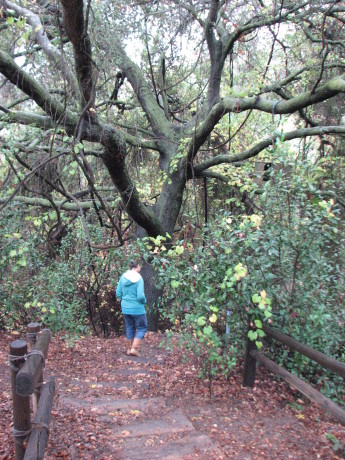
An oak is home to over 300 species. Not counting human. Whether you are planting small plants in pots, ornamentals in your yard or a food forest, you need plants that will provide an upper canopy for others. If you have small plants, then you will have a short canopy. Maybe your canopy is a tomato plant. Maybe its an oak. Whatever it is, canopy has many functions.
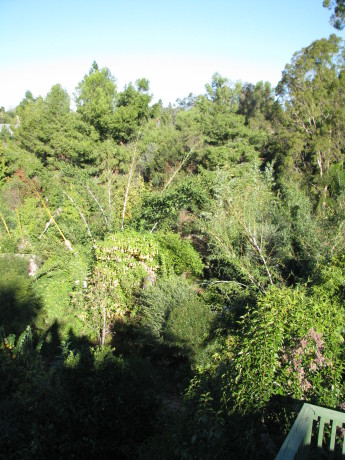
Upper canopy provides shade so that other plants can grow. It drops leaves, bark, flowers and seeds and/or fruit to provide compost and food for all levels of animals down to soil microbes. Canopy provides protective shelter for many kinds of mammals, birds, reptiles and insects as they hide under the leaves. A mature oak is home to over 300 species. Old scarred canopy full of holes is the natural home for honeybees, and many types of bird and other animal. It is a storage unit for acorns gathered by woodpeckers. Where you have animals, you have droppings. All the poo, feathers, regurgitated pellets, fur, scales and other organic waste that falls from canopy is vitally important for the health of the soil below.
Canopy provides a perch for raptors and larger birds that help with rodent control.
Canopy helps slow the wind; the fewer trees we have the harder the winds. Canopy also filters the wind, blocking dust and other debris. Canopy helps cool and moisturize the wind. The leaves of canopy trees help buffer the rain. Rain on bare ground is as compacting as driving over the dirt with a tractor. If rain hits leaves it bounces, rolls or shatters. Rain can then hit other layers below the canopy, finally rolling through leaf mulch to percolate into the soil without compacting it.
Canopy catches moisture as well. Here in Southern California we may not receive a lot of rain, but we do have moisture during the night.
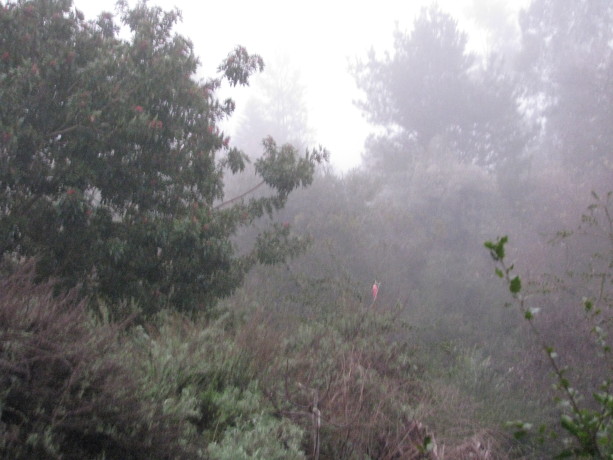 Often I’ve walked through Finch Frolic Garden of a morning to feed the hens, and the garden sounded as if it had its own special rain cloud over it. That is because moisture condenses on the leaves and rolls off. The more canopy and the higher the canopy, the more water we can collect. In that same way, canopy begins to hold humidity on the property, which the rest of the guild contributes to. Pollen dries out. With longer, hotter, drier summers there is worse pollination even if the pollinators are active, because the pollen isn’t viable. Less humidity equals fewer fruits, nuts and vegetables. Therefore, the more canopy, and other parts of a guild, the moister the air and the better the harvest.
Often I’ve walked through Finch Frolic Garden of a morning to feed the hens, and the garden sounded as if it had its own special rain cloud over it. That is because moisture condenses on the leaves and rolls off. The more canopy and the higher the canopy, the more water we can collect. In that same way, canopy begins to hold humidity on the property, which the rest of the guild contributes to. Pollen dries out. With longer, hotter, drier summers there is worse pollination even if the pollinators are active, because the pollen isn’t viable. Less humidity equals fewer fruits, nuts and vegetables. Therefore, the more canopy, and other parts of a guild, the moister the air and the better the harvest.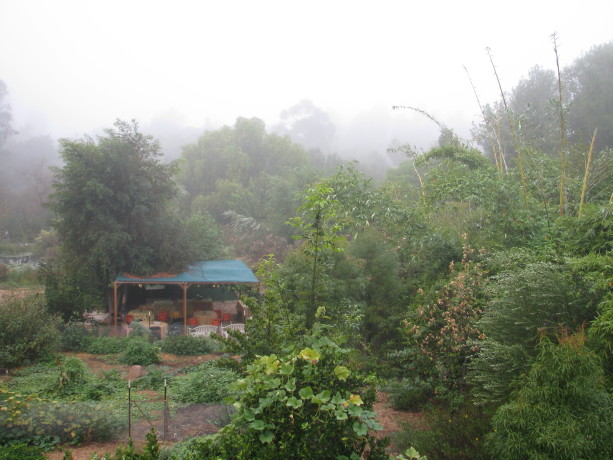
Canopy is in connection with all other plants in its community, linked via webs called mycorrhizal fungi. Through these webs the canopy sends chemical messages and nutrients to other plants. Every plant in the community benefits from the strong communications from the canopy trees.
Canopy builds soil. Canopy trees are large on top and equally large underground. Tree root growth can mirror the height and width of the above-ground part, and it can be larger. Therefore canopy trees and plants break through hard soil with their roots, opening oxygen, nutrient and moisture pathways that allow the roots of other plants passage, as well as for worms and other decomposers. As the roots die they become organic material deep in the soil – effortless hugelkultur; canopy is composting above and below the ground. Plants produce exudates through their roots – sugars, proteins and carbohydrates that attract and feed microbes. Plants change their exudates to attract and repel specific microbes, which make available different nutrients for the plant to take up. A soil sample taken in the same spot within a month’s time may be different due to the plant manipulating the microbes with exudates. Not only are these sticky substances organic materials that improve the soil, but they also help to bind loose soil together, repairing sandy soils or those of decomposed granite. The taller the canopy, the deeper and more extensive are the roots working to build break open or pull together dirt, add nutrients, feed and manage microbes, open oxygen and water channels, provide access for worms and other creatures that love to live near roots.
Canopy roots have different needs and therefore behave differently depending upon the species. Riparian plants search for water. If you have a standing water issue on your property, plant thirsty plants such as willow, fig, sycamore, elderberry or cottonwood. In nature, riparian trees help hold the rain in place, storing it in their massive trunks, blocking the current to slow flooding and erosion, spreading the water out across fields to slowly percolate into the ground, and turning the water into humidity through transpiration. The roots of thirsty plants are often invasive, so be sure they aren’t near structures, water lines, wells, septic systems or hardscape. Some canopy trees can’t survive with a lot of water, so the roots of those species won’t be destructive; they will flourish in dry and/or well-draining areas building soil and allowing water to collect underground.
In large agricultural tracts such as the Midwest and California’s Central Valley, the land is dropping dramatically as the aquifers are pumped dry. Right now in California the drop is about 2 inches a month. If the soil is sandy, it will again be able to hold rainwater, but without organic materials in the soil to keep it there the water will quickly flow away. If the soil is clay, those spaces that collapse are gone and no longer will act as aquifers… unless canopy trees are grown and allowed to age. Their root systems will again open up the ground and allow the soil to be receptive to water storage. Again, roots produce exudates, and roots swell up and die underground leaving wonderful food for beneficial fungi, microbes, worms and all those soil builders. The solution is the same for both clay and sandy soils – any soil, for that matter. Organic material needs to be established deep underground, and how best to do that than by growing trees?
In permaculture design, the largest canopy is often found in Zone 5, which is the native strip. In Zone 5 you can study what canopy provides, and use that information in the design of your garden.
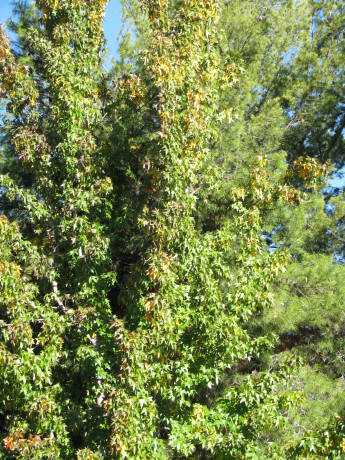 How do you achieve canopy in your garden? If your canopy is something that grows slowly, then you will need to nursery it in with a fast-growing, shorter-lived tree that can be cut and used as mulch when the desired canopy tree becomes well established. Some trees need to be sacrificial to insure the success of your target trees. For instance, we have a flame tree that was part of the original plantings of the garden. It is being shaded out by other trees and plants, and all things considered it doesn’t do enough for the garden to be occupying that space (everything in your garden should have at least three purposes). However a loquat seeded itself behind the flame tree, and the flame tree helped nursery it in. We love loquats, so the flame tree may come down and become buried mulch (hugelkultur), allowing that sunlight and nutrient load to become available for the loquat which is showing signs of stress due to lack of light. With our hotter, drier, longer summers, many fruit trees need canopy and nurse trees to help filter that intense heat and scorching sunlight. Plan your garden with canopy as the mainstay of your guild.
How do you achieve canopy in your garden? If your canopy is something that grows slowly, then you will need to nursery it in with a fast-growing, shorter-lived tree that can be cut and used as mulch when the desired canopy tree becomes well established. Some trees need to be sacrificial to insure the success of your target trees. For instance, we have a flame tree that was part of the original plantings of the garden. It is being shaded out by other trees and plants, and all things considered it doesn’t do enough for the garden to be occupying that space (everything in your garden should have at least three purposes). However a loquat seeded itself behind the flame tree, and the flame tree helped nursery it in. We love loquats, so the flame tree may come down and become buried mulch (hugelkultur), allowing that sunlight and nutrient load to become available for the loquat which is showing signs of stress due to lack of light. With our hotter, drier, longer summers, many fruit trees need canopy and nurse trees to help filter that intense heat and scorching sunlight. Plan your garden with canopy as the mainstay of your guild.Therefore a canopy plant isn’t in stasis. It is working above and below ground constantly repairing and improving. By planting canopy – especially canopy that is native to your area – you are installing a worker that is improving the earth, the air, the water, the diversity of wildlife and the success of your harvest.
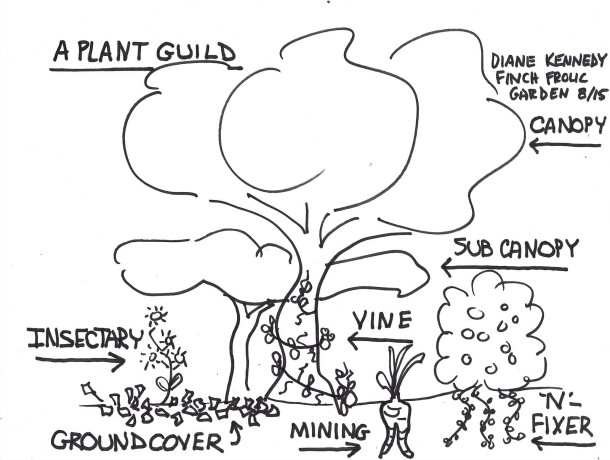
What makes up a plant guild. Canopy is improving the water storage of the soil and increasing potential for aquifers. The more site-appropriate, native canopy we can provide in Zone 5, and the more useful a canopy tree as the center of a food guild, the better off everything is. All canopy asks for in payment is mulch to get it started.
Next week we’ll explore sub-canopy! Stay tuned! You can find the entire 9-part Plant Guild series here: Plant Guilds: What are they and how do they work? The first in a series. , Plant Guild #3: Sub-Canopy , Plant Guild #4: Nitrogen-Fixers, Plant Guild #5: Mining Plants, Plant Guild #6: Groundcovers, Plant Guild #7: Vines, Plant Guild #8: Insectiaries, Plant Guild #9: The Whole Picture.
- Animals, Bees, Birding, Compost, Fungus and Mushrooms, Gardening adventures, Heirloom Plants, Hugelkultur, Living structures, Natives, Other Insects, Perennial vegetables, Permaculture and Edible Forest Gardening Adventures, Photos, Ponds, Rain Catching, Recycling and Repurposing, Reptiles and Amphibians, Seeds, Soil, Water, Water Saving, Worms
October Garden
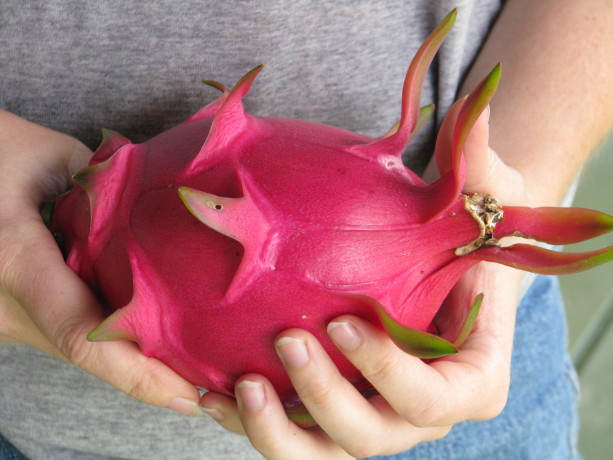
A huge dragonfruit; this kind is white inside. October is one of my favorite months, even when we’re on fire here in Southern California. This year we’ve been saved, and October is moderate in temperature and lovely.
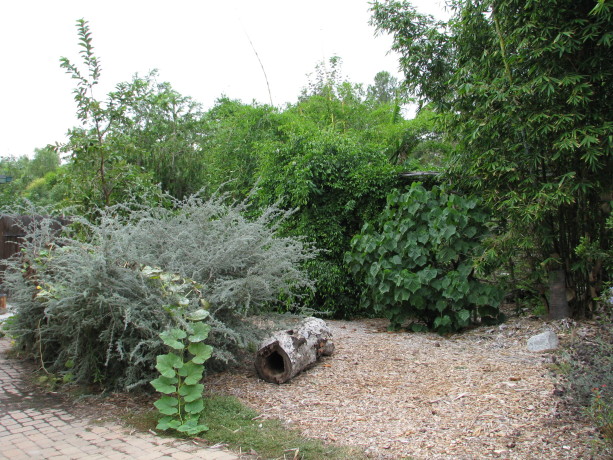
A volunteer kabocha squash vining its way through a bush. 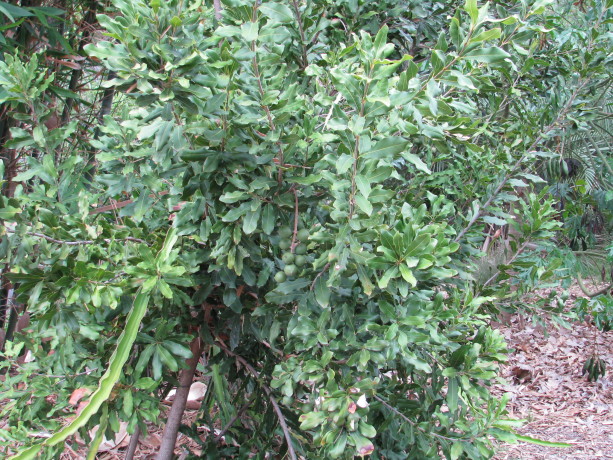
Our first ripeing macadamia harvest from a 3 year old tree, with a dragonfriuit snaking through. 
Edible hibiscus, volunteer nasturtiums and pathway across the rain catchment basin. 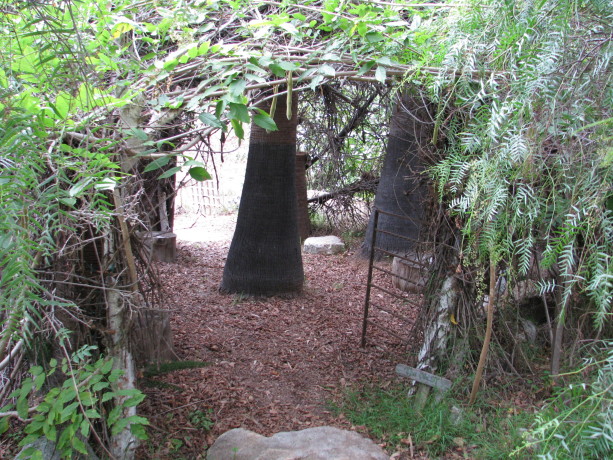
Into the wisteria-covered Nest. Summer has lost her vicious grip and we have time until the holiday rush and winter cold. Finch Frolic Garden has withstood the heat, the dry, the inundations, the snow and the changes, all without chemicals or much human intervention.
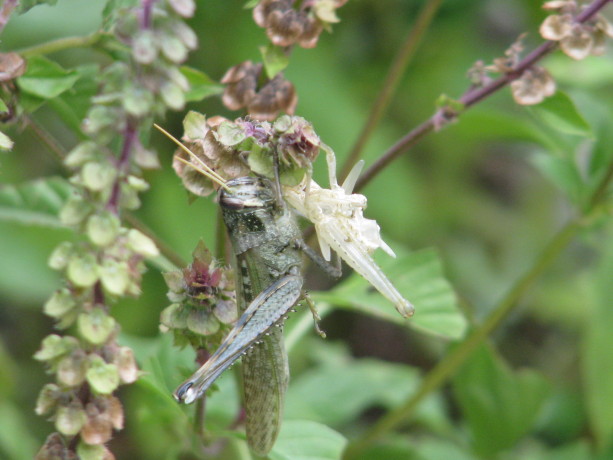
Grasshopper freshly out of last instar. 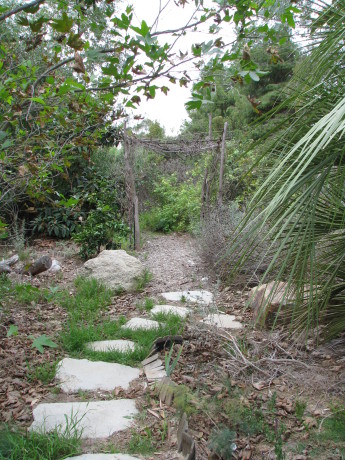
The curly willow trellis. We’ve lost some trees and shrubs this year, but that is mostly due to the faulty irrigation system which delivers too much or too little, and is out of sight underground.
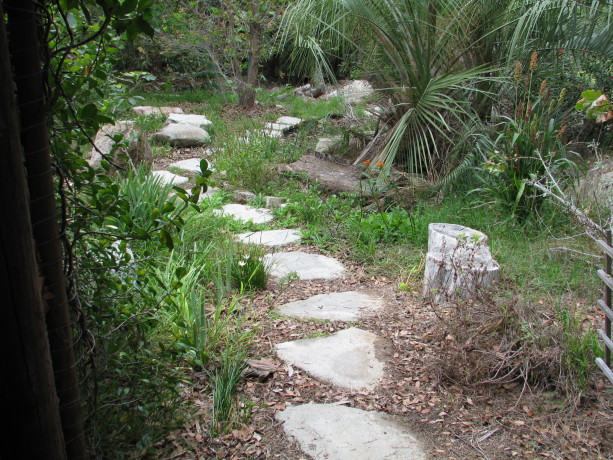
Urbanite pathway. 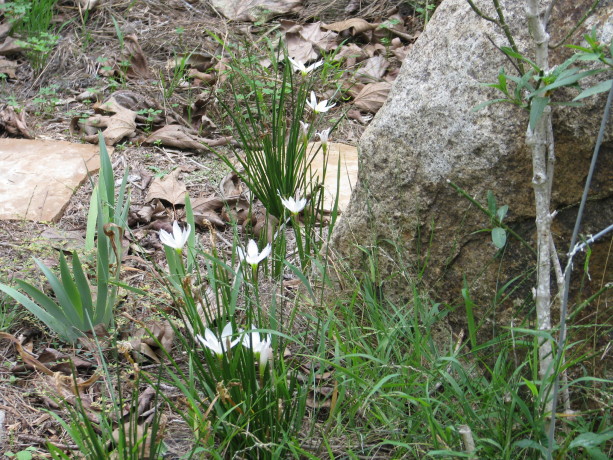
Bulbs will pop up year round for wonderful surprises. Permaculture methods in sheet mulching, plant guilds, swales, rain catchment basins, and the use of canopy have pulled this garden through.
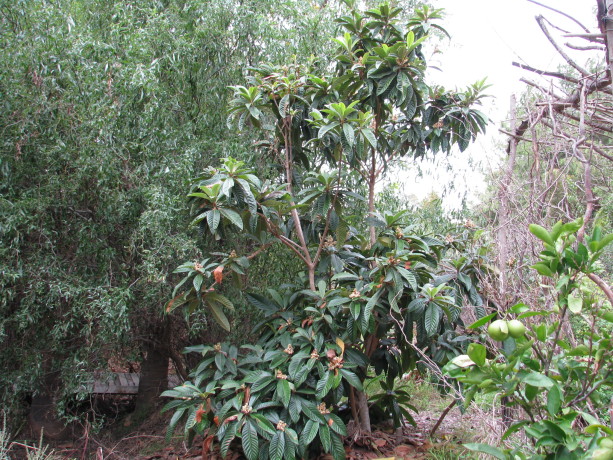
Loquat in bloom. 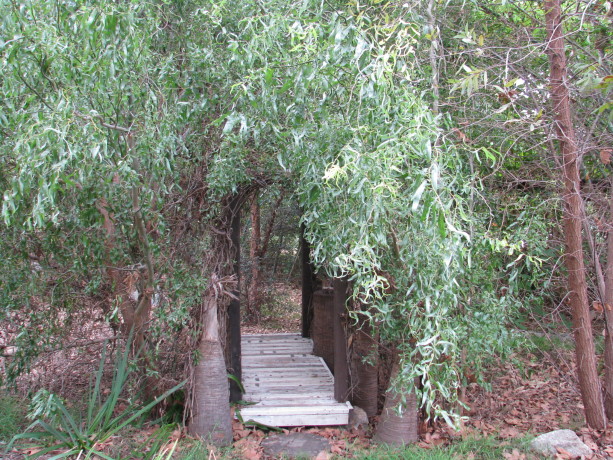
Bridge over currently dry streambed. 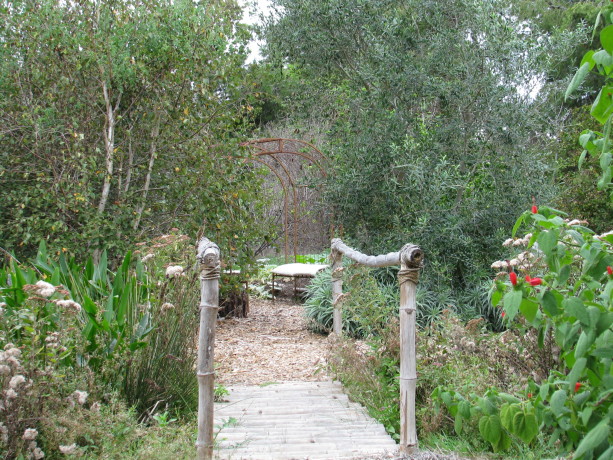
Bamboo bridge. 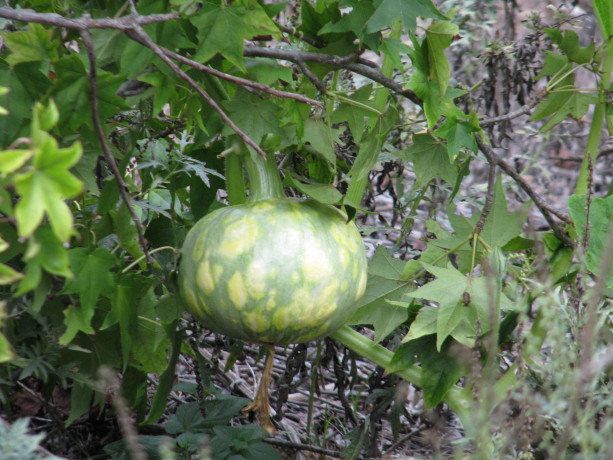
A gourd in a liquidamber. The birds, butterflies and other insects and reptiles are out in full force enjoying a safety zone. A few days ago on an overcast morning, Miranda identified birds that were around us: nuthatches, crows, song sparrows, a Lincoln sparrow, spotted towhees, California towhees, a kingfisher, a pair of mallards, a raven, white crowned sparrows, a thrush, lesser goldfinches, house finches, waxwings, robin, scrub jays, mockingbird, house wren, yellow rumped warbler, ruby crowned kinglet, and more that I can’t remember or didn’t see.
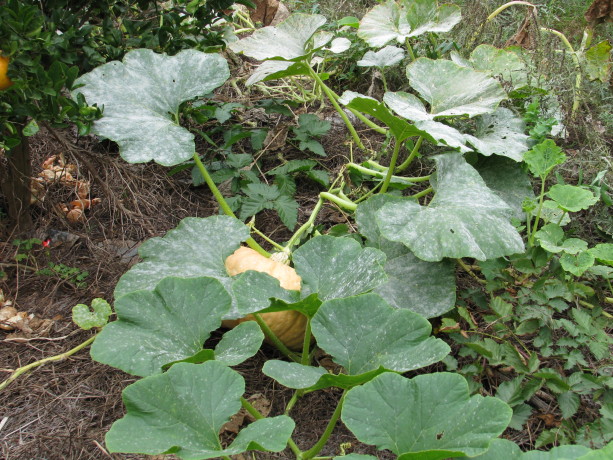
Squash! 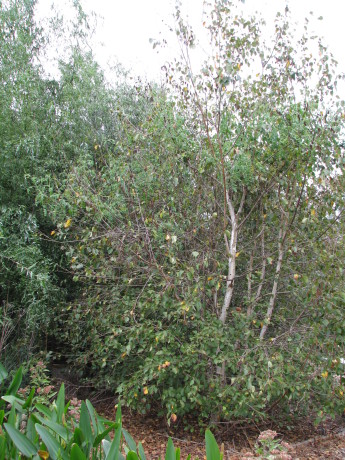
This birch has strange red fruit in its top boughs… 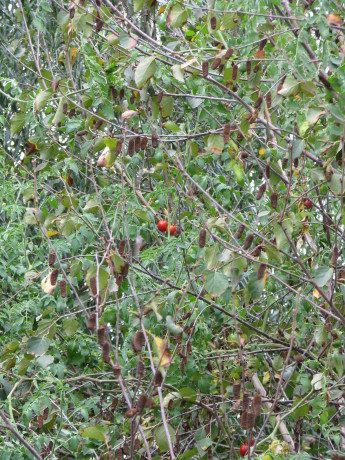
…a volunteer cherry tomato that is fruiting inconveniently ten feet up. Birds have identified our property as a migratory safe zone. No poisons, no traps. Clean chemical-free pond water to drink. Safety.

Squash and gourds happily growing out of the hugelkultur mound. 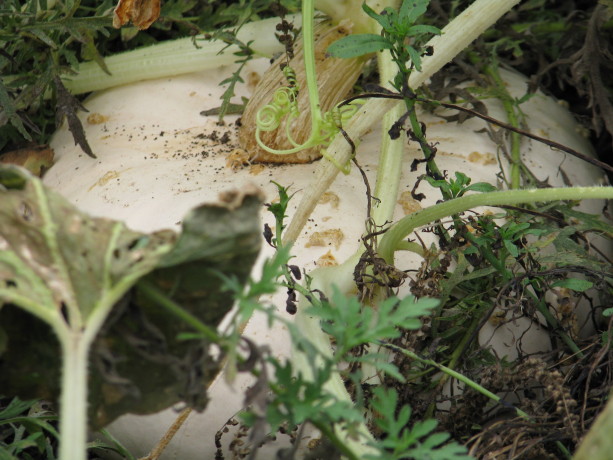
A surprise pumpkin hiding in the foliage. 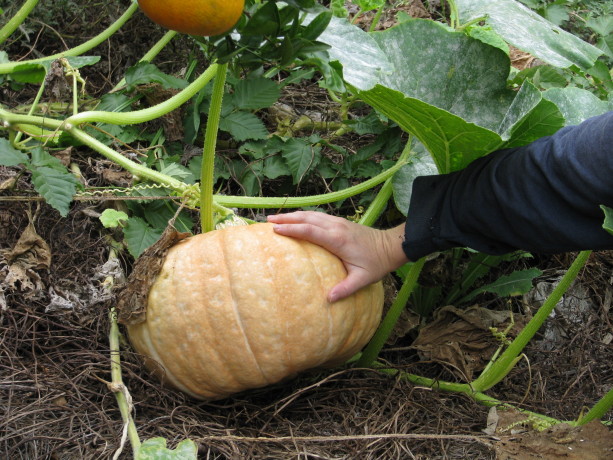
A huge and lovely gourd. 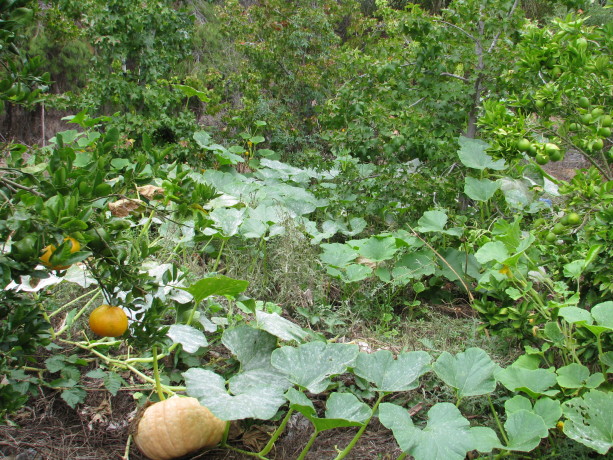
Vines taking advantage of vertical spaces by going up the trees. You can provide this, too, even in just a portion of your property. The permaculture Zone 5.
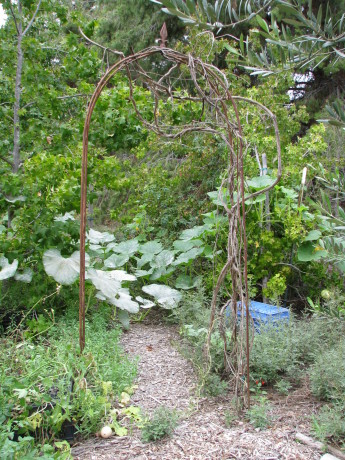
Why did the gourd cross the road? To climb up a liquidamber, apparently. 
A glimpse of pond through the withy hide 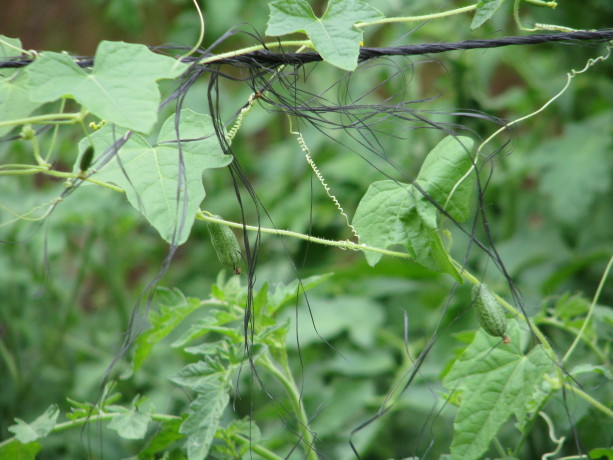
Mouse melons on a tiny vine. More cucumber than melon, they grow to be olive-sized. 
Time for me to get in the water and trim back the waterlilies before the water temperature drops! 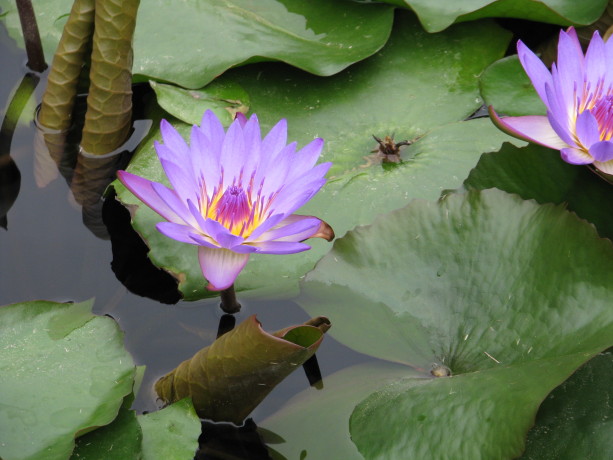
Purple water lilies in the pond. I’m indulging in showing you photos from that overcast October morning, and I hope that you enjoy them.

Eden rose never fails. 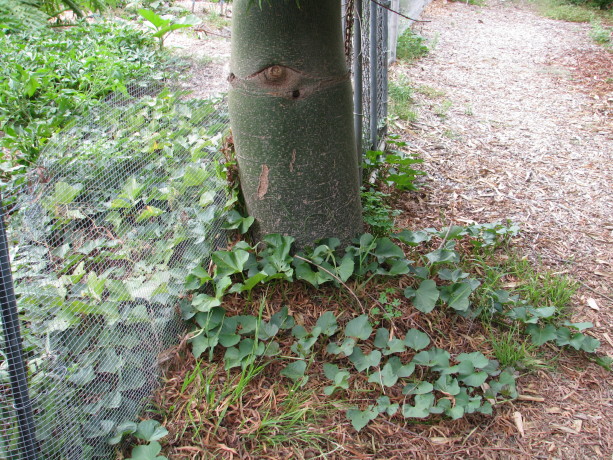
Sweet potato vines escaping the veggie garden; the leaves are edible. 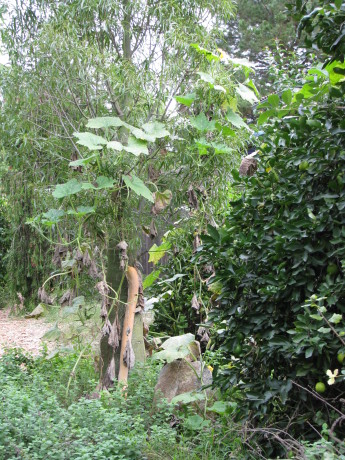
See the long tan thing on the trunk? That’s a zucchino rampicante, an Italian zucchini. Eat it green, or leave it to become a huge winter squash. 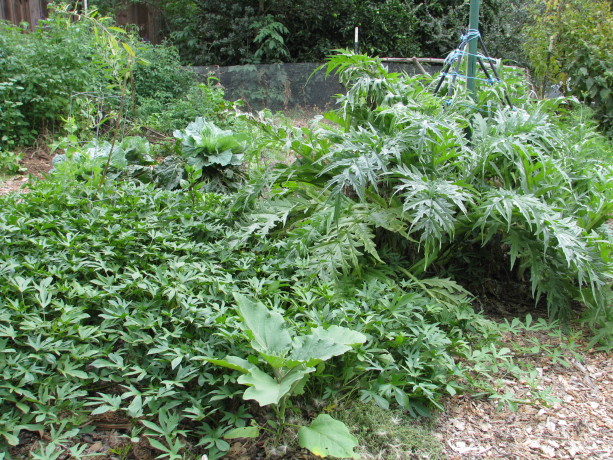
Violetta artichokes regrowing in our veggie garden, with a late eggplant coming up through sweet potato vines. - Animals, Bees, Birding, Compost, Fungus and Mushrooms, Gardening adventures, Health, Hugelkultur, Microbes and Fungi, Natives, Other Insects, Permaculture and Edible Forest Gardening Adventures, Pets, Rain Catching, Seeds, Soil, Water, Water Saving, Worms
Lawn Care and Lawn Alternatives for Drylands
Drought restrictions have caused many people to turn the water off of their lawns; many have already taken that leap years ago. One of the main questions I field now is what to do with that nasty patch that once was a lawn. There are many low-water-use alternatives.
First, please don’t use artificial turf or gravel. Read about why by following the links to past blogposts.
You can have a lawn and not use as much water, and not add any chemicals to it, by understanding how grass grows. You can starting learning everything about lawn caring at ngturf.com/area-calculator/.
If you want and/or need a lawn space, make it as minimal as possible. If you are going to reseed, choose a California native seed that withstands the drought and our alkaline soil. Creeping red fescue is a good choice that grows tall and floppy unmowed, but is a walkable/playable lawn if mowed.
A grass plant spreads at its base, not its tip. Grass needs its blades to produce food. Common mowing techniques recommend mowing low, but that is doing your lawn harm and resulting in the need for aeration and chemical fertilizers. When you mow low, the stressed grass plant needs to push lots of energy into quickly growing more blades to feed its roots. Most weeds have a growing point at their tip and with a strong weed killer it can be stopped. Mow as high as your mower allows – 4 inches if possible. High mowing allows the grass plant to keep its blades for food making, and to put energy into deep root growth and into spreading. Mowing high cuts the tops off the weeds, and the height of the grass shades out weed seeds so they can’t germinate.
Water deeply, and less frequently. Catch an inch of water in a cup set under your lawn irrigation and shut the water off. Don’t water again until the grass shows that it needs it. Constant irrigation, especially on short grass where the soil is exposed, and rainwater on bare earth is as compacting as running a tractor over the ground. When the earth is compacted water just won’t penetrate. You pour water onto the grass which runs off or evaporates. Your grass can’t grow deep tap roots and is slowly starved to death.
Use a mulching mower and allow the grass clippings to return to the lawn. Stop using chemical fertilizers. Completely. In permaculture we feed the soil and not the plants. Healthy soil has billions of fungi, bacteria, nematodes, amoebas, and other creatures in every teaspoon. This zoo of soft-bodied creatures break down organic matter and make nutrients in the soil available for roots to feed from. The better the soil health, which means the more microbial activity and population, the loamier the soil and therefore the better water penetration as well. Instead of dumping high nitrogen fertilizer on your lawn, use compost, actively aerated compost tea , and chopped up leaves. (If you don’t have a mulcher attachment on your mower, or a blower with a reverse vacuum attachment, then put leaves in a trash can and use a string mower to chop them up- while wearing eye protection of course!). Chopped up leaves are all you need to fertilize anything. Best of all they don’t harm your pets or family, unlike chemical fertilizers.
If you don’t want a lawn, then figure out how you want to use the space. Do you want to just see the area from your windows? Do you want a meditation garden? Room for kids and pets to play? An outside BBQ spot? Decide how best to use this space. If you aren’t using every square inch of your property, you are paying property taxes for nothing.
To get rid of your lawn you don’t need to dig it up. Please save your money. Sheet mulch it. Sheet mulch is an inch of cardboard and/or newspaper topped with 4-6 inches of mulch. Gorilla hair (shredded redwood) or shredded ceder bark spread well and sit lightly on the soil, and you get more for your money. Sheet mulch will turn the grass into mulch and start activating the soil. Best of all, it looks instantly great, to satisfy your neighbors and family. If you have Bermuda or other very determined grass, you may need a thicker layer of cardboard. Sheet mulch now and allow it to sit over the winter and absorb the rains. In the spring you can cut through the cardboard and plant right in the ground.
If you want a low-effort garden, then please go native. We need to replace habitat that has been destroyed and give the animals and insects the food and shelter that they need to survive. Many California native gardens are not well done and look piecemeal and stark. This doesn’t have to be. Look around at the hills; unless you are well into the desert, there are plants of all types everywhere. If you have sheet mulched a green lawn, then allow the grass to die completely before planting natives; they don’t like higher nitrogen from freshly decomposing grass, or the residual from high nitrogen fertilizer. Sheet mulching over the winter and planting in the spring should be fine. If your lawn is already dead, then you can sheet mulch and plant immediately. Then allow the plants to fill out and you don’t need to mulch again.
See how the area looks from your windows. Make pathways that are wide enough to accommodate whomever is going to use it (2 feet wide for one person, 3 feet for two or a bicycle, 4 feet for a wheelchair). Don’t skimp on the pathway material. An ugly or uneven pathway will draw all your attention and no matter what you do around it, it will look bad. A good pathway well done and complementary to your house is important for your own satisfaction and for the resale value of your home as well. Choose destination spots and focal points. Benches, a bird bath, a specimen plant – these are all important. Then choose plants. I highly recommend the book California Native Landscapes by Greg Rubin and Lucy Warren. These are San Diegans so they know what works well in Southern California.
One inch of rain on one acre in one hour is 27,154 gallons of free, neutral pH rainwater. Most lawns are slightly convex so that water runs off of them. That is why there is a bald spot at the highest point where you just can’t keep anything alive. You want to catch all the rainwater -and irrigation water – you can. Catch it, sink it, spread it. Do this with simple earthworks that you can do with a shovel. Perpendicular to the water flow dig shallow swales (level-bottomed ditches). They only need to be an inch deep, or you can go much deeper. They can be filled with large mulch, and sheet-mulched over the top. Rain will then sink into the ground rather than rolling off. Sheet mulch – or any mulch – allows the rain to hit, bounce and then gently fall to earth. Catch every drop that you can, and the best place to catch rain is in your soil.
To further add water retention and nutrition for your microbes, bury wood. Old logs, old untreated building materials (nails and all), shrub cuttings, nasty spiky rose cuttings, palm fronds and trunks, they can all be buried and planted over in a process called hugelkultur. Even old cotton clothing, straw hats, or anything made with natural fibers can be layered with dirt and buried. Get the most from what you’ve already spent money on and let your trash fix your soil.
So, steps would be to decide what you want to do with your lawn area, design the pathways and special areas, determine what kind of plants you want to put there, dig in some earthworks, sheet mulch to kill the grass and weeds, then plant. Natives will need supplemental water (not drip irrigation, but a long soak and then allowed to go dry) until they are established. Then many of them don’t want any supplemental water; some go drought-deciduous, so do your research. A good selection that is lovely and will invite birds and butterflies into your yard might include Cleveland sage (not Mexican bush sage, which becomes very woody), apricot mallow, desert mallow, fairy duster, and ceanothus. Great retail native nurseries are Theodore Payne nursery in Los Angeles and Tree of Life nursery in San Juan Capistrano.
If you don’t want to go native, then consider low-water-use plants such as many Mediterranean herbs. Rosemary, oregano, marjoram, lavender and others interspersed with drought tolerant plants such as bird of paradise, New Zealand flax, rockrose, Pride of Madeira, and a host of interesting succulents in between. Aloe blooms are attractive to hummingbirds.
If you live in areas where there is a real winter, where you receive snowfall, your lawn care to prepare for the cold is quite different. The folks at Yardday have excellent tips to help prepare for snow, and you can read about them here. Keep in mind that the ‘fertilizer’ should be actively aerated compost tea and/or compost, NOT bagged NPK or other chemical or condensed lawn care fertilizer. These concentrated fertilizers kill microbes leaving your soil lifeless, water-repelling dirt.
There are lots of things to do with your lawn that are lovely, useful, interesting and beneficial to wildlife and to the earth. Care for your soil by not poisoning the microbes with chemicals, use your leaves, sheet mulch, and design for low water use. Its worth the effort.
- Animals, Bees, Birding, Compost, Gardening adventures, Health, Microbes and Fungi, Natives, Other Insects, Pets, Ponds, Predators, Quail, Rain Catching, Reptiles and Amphibians, Soil, Water, Water Saving, Worms
Why Buy Rain Barrels if you Own a Pool? Pool Conversion Discount!
Why buy rain barrels if you own a pool? You can collect about 20,000 gallons of rainwater in an average pool, and use it on your landscaping and for swimming if you don’t chlorinate it. If you have a pool or pond and put chemicals into it, or have a saltwater pool or one that is treated with UV light, you really need to read about how toxic those systems really are and how to change your pool into a swimmable, clean pond on PuraVidaAquatic.com. On that site is a host of great information about how bad mosquito fish are, how to make a truly healthy pond, why having a pond in a drought is a great idea and so very important, and so much more. If you live in Southern California and have a pool, you’ll be interested in this Fall Special:
- Animals, Bees, Compost, Gardening adventures, Hugelkultur, Microbes and Fungi, Natives, Other Insects, Permaculture and Edible Forest Gardening Adventures, Rain Catching, Reptiles and Amphibians, Soil, Water, Water Saving, Worms
A Zero Irrigation Garden
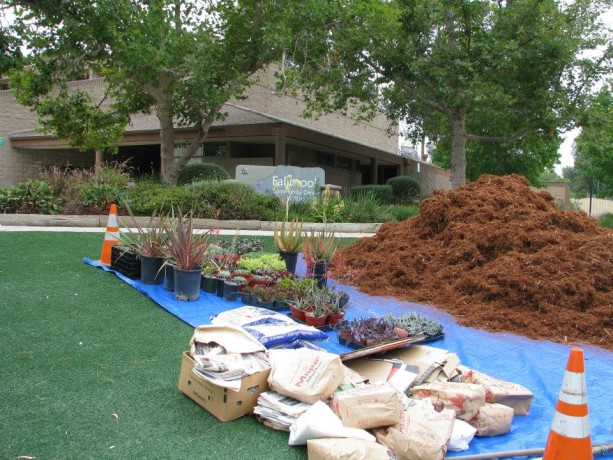
Plants, mulch and newspapers waiting for action. In response to the water cutbacks, the County of San Diego Dept. of Parks and Recreation deemed it necessary to turn off irrigation to the front two planting beds of the Fallbrook Community Center. The plan was to tear out the plants and replace them with decomposed granite and a bench.
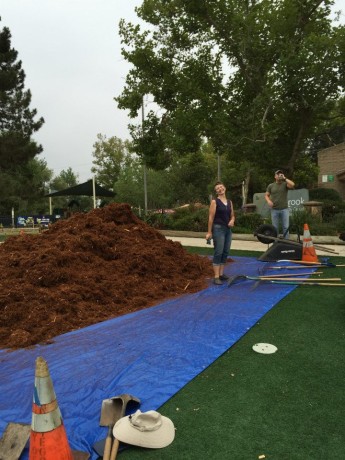
At first this looked like too little mulch. Then it spread, and kept on spreading. You can see the overgrown planter behind me and Bill. Health and fitness instructor Ann Wade, also the president of the Friends of the Fallbrook Community Center, contacted me and I came up with a design using native plants and a variety of succulents that could survive without irrigation. More than that, simple earthworks in the form of swales and small rain catchment basins could be dug to hold run-off, and sheet mulch applied to retain moisture. The plan was accepted and several weeks ago we had a planting.
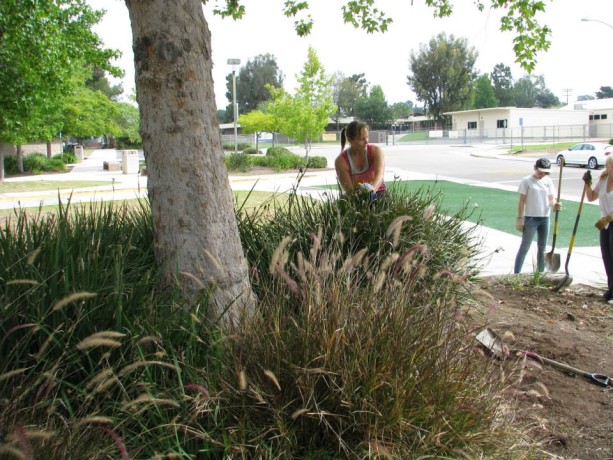
Lynne with the plant that pulled her in. A big portion of the planting was to remove the existing plants that would have died anyway. These plants had been haphazardly installed, and apparently most were leftovers from a long-ago Fallbrook Garden Club plant sale.
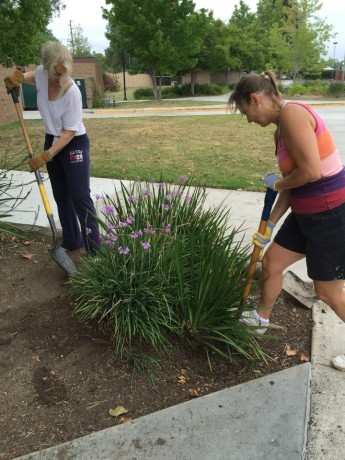
Ann and Lynne tackling a reluctant plant. We replanted as many as we could that could adapt to the lack of irrigation. Others went home with volunteers or were mulched. The Community Center sign was partially blocked, sea lavender had to be cut practically in half to keep it out of the pathway, and some bushes had to constantly shaped. As much as I dislike removing plants, they had to go.
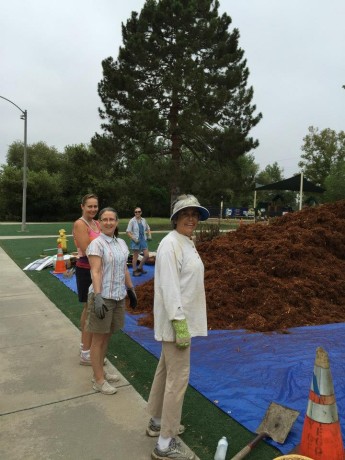
Lynne, Dorothy and Barbara with Miranda in the background. They had no idea what they had volunteered for! On a hot summer’s day many wonderful friends of mine and my daughter arrived to do permaculture at the Community Center. A good portion of the morning was spent hacking out the existing plants.
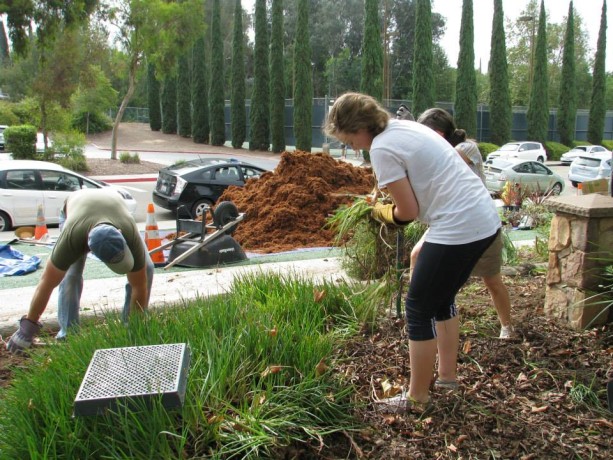
McKenna and Dorothy tackle bulbine. The ground was so hard from years of spray irrigation and rainwater runoff that these plants had to be chopped rather than dug. The roots had formed a solid mat close to the surface in their desperate search for water.
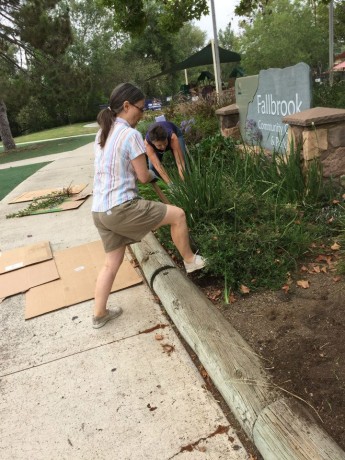
Dorothy and me clearing out the old. These plants blocked the sign. The irrigation had been run the night before, but very little of this water was evident, and some of it showed evidence that it simply ran off. This removal process took much longer than I had anticipated, but after the slaughter we were able to move ahead.
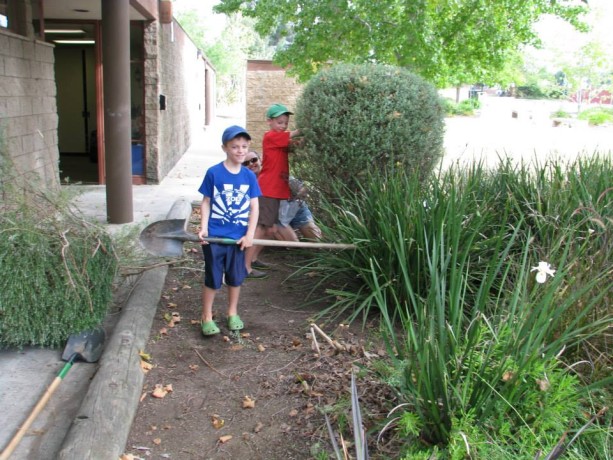
Jakie and Jackson help Miranda cut down a shrub. I dug shallow swales perpendicular to the flow of rainwater from the sidewalk and roof, you can see this for reference. Dug is not the best word here; chopped would be better as the soil was so hard. I also dug some shallow basins around the planting beds, making the soil surface uneven to collect rainwater.
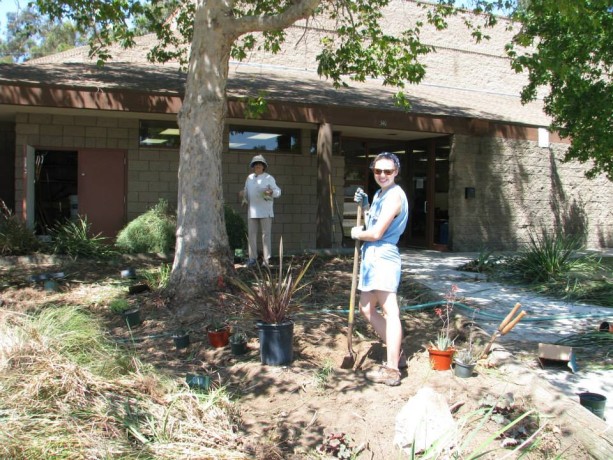
Barbara and Miranda planting in very hard dirt. Each bed sports an old beautiful California sycamore, a riparian tree, and with the reduction of lawn irrigation and termination of irrigation in the beds (however unhelpful that was), these trees could be imperiled. The swales – shallow ditches with level bottoms- would allow rainwater to percolate into the soil and travel deeply to the roots rather than run over the top. Small swales above plants are key to holding rainwater in the soil and preventing flooding and topsoil erosion. Swales are how we can recharge our subterranean waterways, refortify our wells and reestablish summer streambeds.
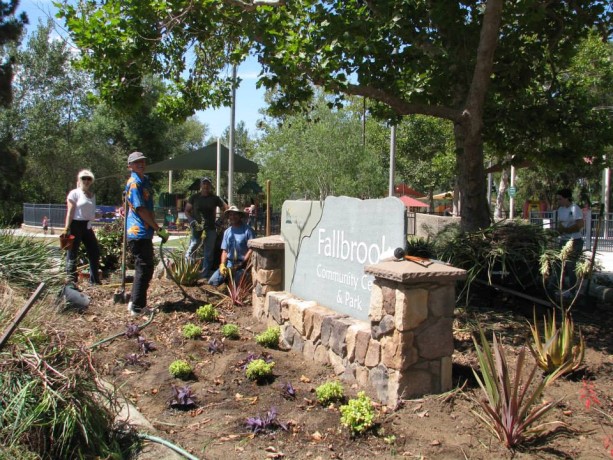
The front planted and watered. Ann, Bob, Bill, Gary and Grace. We had ordered four boulders as well, and these were placed to focus the eye on the sign and the plants rather than the back wall of the Community Center, and to tie in with the stone base of the sign. This sounds easier than it was. To look natural, boulders should be buried 1/4 to 1/2 way into the ground. I’m not sure which was more difficult for the volunteers: to dig a hole in that hard dirt or to move the boulders uphill and into position. Fortunately no fingers or toes were lost and the boulders looked great. They were chosen to be pointy so as not to entice children to sit or stand on them.
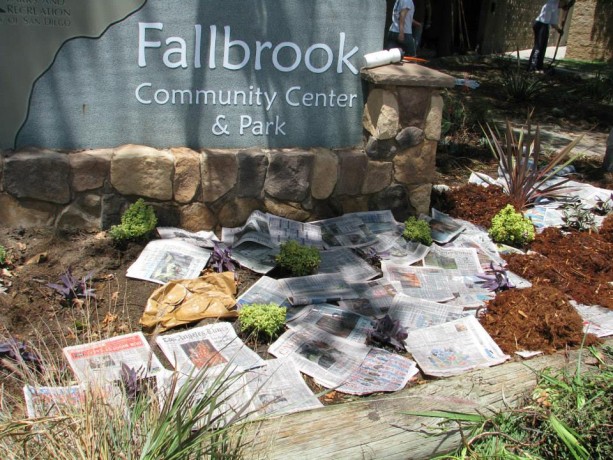
Newspapers and fliers were laid around the plants over a sprinkling of chicken manure. I got to spread that. After placing a selection of California natives appropriate for the shade, part sun and full sun areas, and placing the succulents, we sprinkled a little composted chicken manure over the soil surface and the team placed sheet mulch around the planted plants. Sheet mulch is another inexpensive miracle that can save so much water and improve plant growth in our dry climate.
This manure would help feed microbes as they began to populate the area. On top of that was spread cardboard, newspapers, and leftover freebie magazines (with the glossy cover discarded). We were repurposing trash from the community center back into the planting beds! How cool is that? For native plants, this layer didn’t need to be thick because it was to help nursery in the new plants, suppress weeds, hold in moisture during our hot months, and act as soil protector from rainfall.
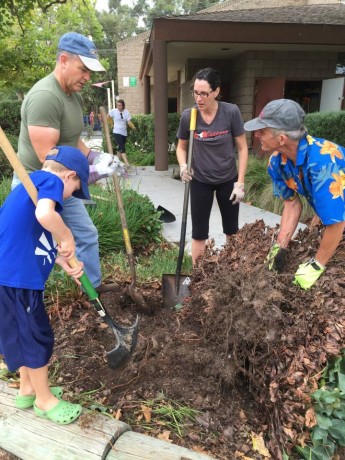
Jakie, Bill, Susan and Bob versus a sea lavender. Rain on bare earth is more compacting than driving a truck over the ground. For thirstier plants such as non-natives, thicker layers of cardboard should be added. As a guide, think of what the plant in question at maturity might have around its base for mulch. An avocado tree would have a very thick layer of leaves and fruit. Avocados and citrus don’t like anything growing around their roots, so they block the sun with their foliage and cover the ground with debris. By adding 1/2″ to 1″ or more cardboard around these trees and those plants that require more moisture, you save a lot of water and give the plant what they need to live and produce without stress. No stress means much better chances of fighting insects and disease. The native plants in this garden were chosen because when established they don’t like additional irrigation water, especially in the summer.
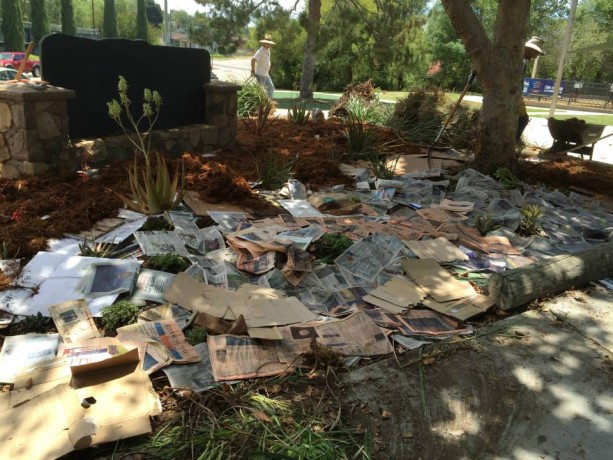
A good layer of newspapers and cardboard. Jake and Gary working hard in the final stretch. Therefore the cardboard layer wasn’t thick. We also spread around some of the branches and leaves from plants we’d removed and topped them with cardboard.
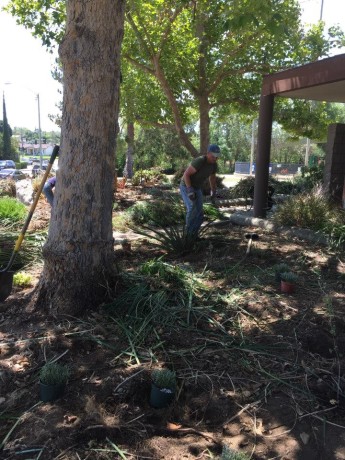
Some old plant material was around to add to the soil health. If the ground had been softer, a lot of the removed plants would have been buried (hugelkultur). These, too, would protect the soil and decompose as great food for the worms and microbes. If the soil had been more forgiving, I would have buried a lot of the removed plants to build the soil. As it was, we were lucky to chisel out planting holes for the one-gallon plants.
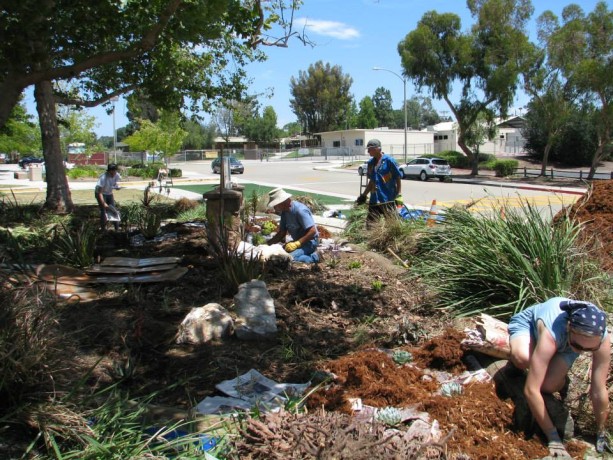
Watering in plants while sheet mulch is being laid. On top of the cardboard was spread gorilla hair mulch. This shredded redwood bark is excellent for use around natives and other vegetation for many reasons. It is fluffy, so it spreads much farther than wood chips and is the better value. The fluffiness also prevents it from laying firmly on the soil so it doesn’t decompose as quickly as wood chips, and most importantly it doesn’t wick moisture from the ground as do wood chips on bare soil. As gorilla hair decomposes it is a better match for our native soil composition than other mulches. It also looks great.
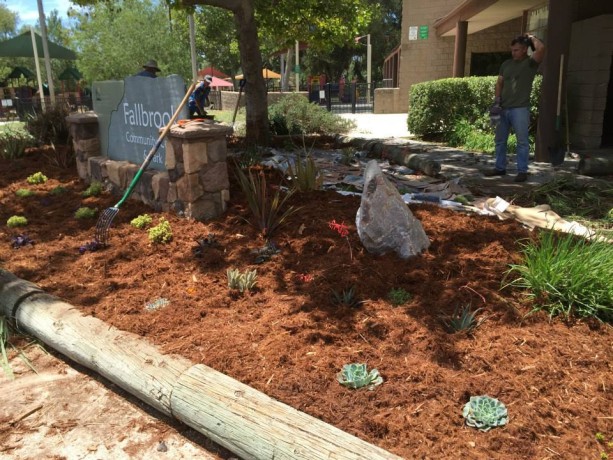
Planted! The plants were watered in around the rootball after being planted, which saved water usage tremendously. I was concerned that the surrounding dirt would wick the moisture away from the new plants, but after 5 days the root balls still had some moisture. I used a watering can and gave them all about a cup of water a week after planting. Today, after three days of triple-digit heat, I watered again and replaced a few plants that had cooked. These were my fault, having misjudged the intensity of the sun on these particular small plants. A few succulent showed signs of being stepped on as well, but overall the plants looked good.
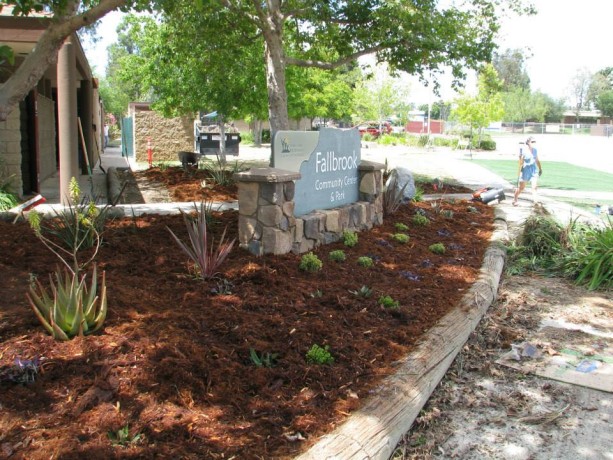
Mission completed, and a visible sign! The natives and succulents were all chosen to be extremely drought tolerant and to attract birds and butterflies. Many non-native plants have very little or no habitat for animals. We’ve removed their food and shelter and replaced them with plants that need far too much water and don’t provide nourishment or adequate nesting areas. The succulents installed will feed hummingbirds and insects, as well as the other natives which will also provide food for other birds.
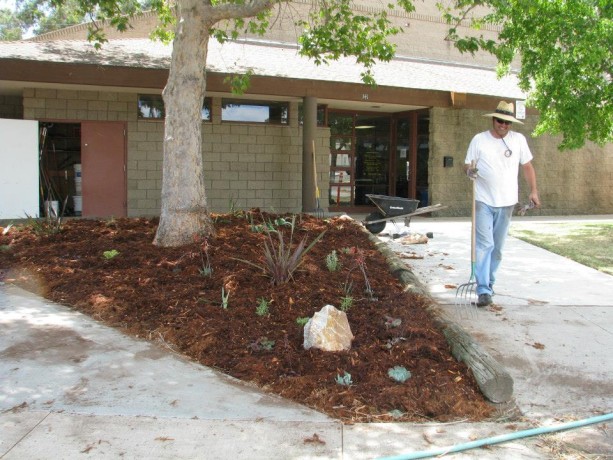
Jake surveys the finished product. A garden should become alive with the movement of animals. Birds, butterflies, bees, lizards… they are the motion and the life of a garden. By using chemicals and only non-natives we rob these creatures of a home and adequate nourishment. By planting natives along with other plants we can share our gardens with the wildlife that so desperately need habitat.
The gorilla hair also complemented the bark of the sycamores – a happy accident. The beauty of the trees popped with the new design and mulch.
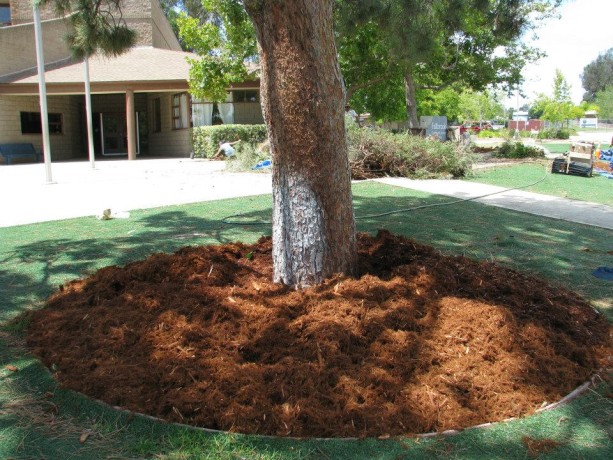
Sheet mulch around the base of the old pine. Be sure to leave a few inches between the trunk and the mulch so as not to rot the bark. The base of the historic Christmas pine was also sheet mulched to protect the roots from more compaction and to try and help counteract a little of the damage done to it by the artificial turf that was laid some years ago.
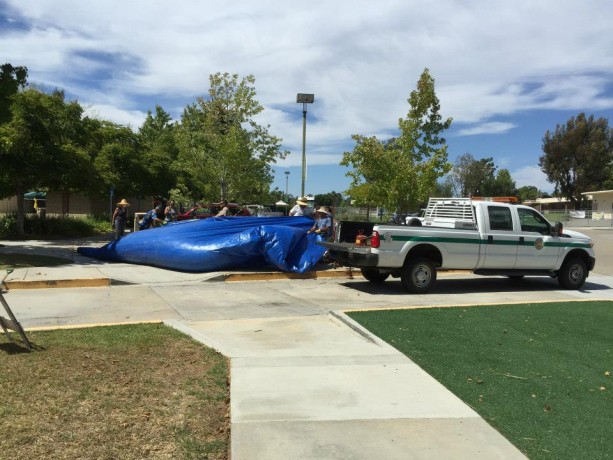
A successful and easy way to move a tarp full of mulch! Because the gorilla hair spread farther than expected, the extra was used over cardboard in two additional planters which gave the front of the center a uniform look. I could almost hear the plants sighing in relief.
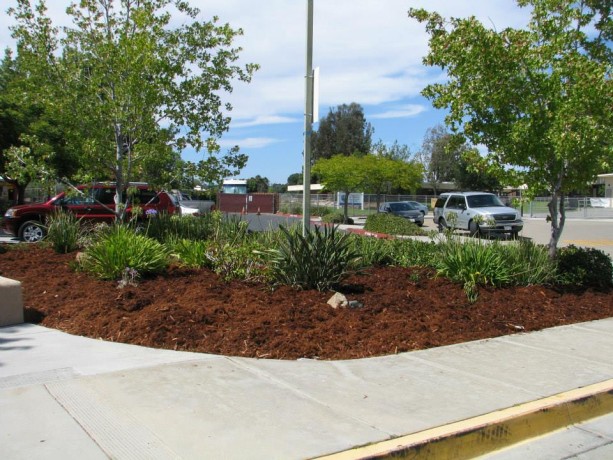
Extra mulch was used for another planting bed. If funds become available, plants can be added by simply cutting through the cardboard to plant. I was very fortunate to have been involved in this project, as it demonstrates permaculture techniques to the public and is in a very visual position in our community. It is also in a County facility, so perhaps other facilities will begin implementing permaculture practices to save water and build soil throughout San Diego.
This project was a long, hard job and if not for the dedication and affection of my friends and daughter it most certainly would not have come to fruition. There were many sore muscles the day after. Thanks to District Park Manger Jake Enriquez for okaying the project, Ann Wade for initiating the scheme and working with great spirits from start to finish (and providing frozen yogurt at break time!), Bill, McKenna and Grace Wade, Miranda Kennedy for sticking with her mom with every new ‘project’ that turns out to be long hours of hard labor, Bob Lloyd of PuraVida Aquatics who drove from Ramona to work hard in the sun, Susan, Jackson and Jake Liebes and Gary Beeler of the Fallbrook Land Conservancy’s Native Plant Restoration Team, Lynne, Dorothy and Barbara who are fellow students of Ann’s, wonderful friends of mine and who won some tough battles with reluctant plants, and Johanna, the FCC leader, and the staff of Live Oak Park who came in at the end for the grand finale. You all are wonderful people, and thank you for helping bring permaculture to a public facility!
- Animals, Compost, Fungus and Mushrooms, Gardening adventures, Heirloom Plants, Natives, Other Insects, Perennial vegetables, Permaculture and Edible Forest Gardening Adventures, Pets, Predators, Recipes, Reptiles and Amphibians, Seeds, Soil, Worms
Argentine Ants
Most of the annoying ants we suffer with in California, especially here in San Diego, are actually an invader called Argentine Ants. They arrived via shipboard to Louisiana, and have spread throughout warmer climates. Argentine ants are so successful because they have multiple queens per colony and therefore recognize all other Argentine ants as family. They don’t fight among themselves. There is a colony that stretches from San Diego to near San Francisco.
Argentine ants have nudged out many of our native ants, which isn’t a good thing. We need our native ants for decomposition. Argentine ants harm arthropods and have a terrible effect on the ecosystem; here in Southern California their impact on horned lizards have been devastating. The only way you can tell them apart (unless you have very tiny ants or black or red ants) from natives of similar size is by studying them with a microscope. This blog post shows great photos of the difference between ants.
Argentine ants farm aphids on plants and trees, milking the bugs for their ‘honeydew’, a sweet excretion. They will bring aphids to your plants and farm them there. They will also farm scale underground around the trunks or stems of plants, especially natives such as California Lilac (ceanothus spp). By the time the plant show stress and the ants begin to farm aphids above ground, much of the damage has already been done.
As much against annihilation as I am, this ant does terrible harm to our environment and should be happily living back in its native South American river area. Not only is it directly harmful, but because it is everywhere it incites people to spray poisons that kill all the beneficial insects as well.
The best solution is a borax bait trap that you can make your own. Borax is a powerful killer and should not be used liberally. Yes, it is sold as a fertilizer and as a laundry additive, and that borax kills insects and beneficial flora and fauna as it enters the watershed and soil. It is toxic to pets and children. However, just a little solution used wisely can really help control these ants.
I use old spice containers that have the plastic shaker ends on them for the bait traps. The holes are small enough to prevent other insects or animals from entering the jar, but are big enough for the ants. Otherwise you can use butter tubs with small holes punched in the top. Put a cotton ball inside the containers.
It is recommended to make a 1% borax solution rather than a stronger one because you don’t want to kill the ants immediately. You want them to bring the bait back to the nest and feed it to the queen. I know that is horrible, but they would definitely do the same to us if they could.
This recipe is based on research done by entomologist John Klotz at UC Riverside. Dissolve 1 tsp. boric acid (borax) and 6 tablespoons sugar in two cups of warm -preferably distilled or dechlorinated – water. Soak cotton balls in the bait solution and place in spice shakers or plastic tubs with holes in the lid. The containers will also keep the cotton ball from drying out quickly. Place in a shady location in the path of Argentine ants. Clean the container and replace the cotton ball weekly (it will become moldy). At first the bait traps will attract more ants, which is fine because they are bringing the bait back to their nests. If you want to kill the ants immediately, add more boric acid. For long-term control, reduce the boric acid to 1/2% to allow worker ants to feed for a long time before they die and therefore bring more back to the nest.
Keep the excess boric acid solution capped and in the refrigerator well labeled, so no one drinks the sweet drink.
Be sure to keep an eye out for ant activity around the base of your native plants, and if you have aphids on the leaves of plants you no doubt have ants farming them there. Argentine ants are pests we really can eliminate without fear, and allow our native ants to reclaim their territory.
- Building and Landscaping, Compost, Composting toilet, Gardening adventures, Health, Houses, Hugelkultur, Humor, Living structures, Natives, Permaculture and Edible Forest Gardening Adventures, Ponds, Rain Catching, Recycling and Repurposing, Soil, Special Events, Water, Water Saving
How To Evaluate Your Property: The July Lecture In The Garden at Finch Frolic
Finch Frolic Garden’s Program in the Garden Series for July:
Analyzing Property for Maximum Use:
Site Evaluation Step-by-Step
Sunday, July 26, 2 – 4 pm
Looking for property? Creating a landscape? Planting a garden? Building a house? Diane Kennedy of Finch Frolic Garden will take you through the steps of evaluating your site for maximum effectiveness with the least labor and cost.
This class is for the average homeowner, with little or no permaculture background. All terms will be defined and explored. Guaranteed, you will leave the class excited about your property, and able to find new potential in it.
In permaculture, 99% of the work should be in design, and only 1% in labor, so find out how to look at property with new eyes and start designing! Participants are encouraged to bring a Google Maps image of their property to work on.
We will, of course, offer homemade vegetarian refreshments. Cost is $25 per person, mailed ahead of time. Finch Frolic Garden is located at 390 Vista del Indio, Fallbrook. Please RSVP to dianeckennedy@prodigy.net . More information can be found at www.vegetariat.com. You’ll love what you learn!
- Animals, Bees, Birding, Building and Landscaping, Chickens, Compost, Fungus and Mushrooms, Gardening adventures, Heirloom Plants, Hugelkultur, Microbes and Fungi, Natives, Other Insects, Perennial vegetables, Permaculture and Edible Forest Gardening Adventures, Pets, Ponds, Predators, Quail, Rain Catching, Recycling and Repurposing, Seeds, Soil, Special Events, Water, Water Saving, Worms
Water Harvesting With Simple Earthworks
Finch Frolic Garden’s Program In The Garden Series for June:
Shaping the land to harvest energy and water – easily!
With permaculturalist Jacob Hatch of Hatch Aquatics and Landscaping
Use 30% – 70% less water on your landscape!
Jacob Hatch of Hatch Aquatics will show you how to catch free, precious, neutral pH rainwater using earthworks. Whether you use a trowel or a tractor, you can harvest that free water. Each attendee will receive a plant! We will, of course, offer homemade vegetarian refreshments. Cost is $25 per person, mailed ahead of time. Finch Frolic Garden is located at 390 Vista del Indio, Fallbrook. Please RSVP to dianeckennedy@prodigy.net . More information can be found at www.vegetariat.com. You’ll love what you learn!
- Animals, Bees, Birding, Building and Landscaping, Gardening adventures, Hugelkultur, Microbes and Fungi, Natives, Other Insects, Pets, Predators, Quail, Rain Catching, Reptiles and Amphibians, Water, Water Saving, Worms
Artificial Turf? Big Mistake.
Want a green lawn that needs no irrigation or mowing? That sounds ideal. As with most products that sound too good to be true, so it is with artificial turf. Modern artificial turf is not much like the Astroturf of old. Artificial grass blades are usually made of polyethylene, polypropylene or nylon, which create soft, harder or stiff blades respectively. These are anchored in an infill material that is usually a mixture of sand and ground up recycled automobile tires among other things. Utilizing recycled tires should give this product big bonus points; however, this material will leach heavy metals into the ground, contaminating the dirt for decades. When heated, the plastic and rubber will release toxins into the air as well.
Heat is the biggest problem with artificial turf, according to King Green. The infill made of plastic and rubber is a thermal mass: as it sits in the sun it absorbs and radiates heat. For example, at 6 pm, an hour before the Women’s World Cup in Canada began at the end of a nice 75 degree day, the artificial turf on which they were to play measured 120F. Where daytime temperatures rise to 100F, the turf could measure up to 180F. Having turf where children or animals play can cause burns.
Radiating heat from thermal mass such as hardscape (usually cements and asphalt), expanses of gravel, and especially artificial turf will heat up homes and is a contributor to more energy usage for air conditioners and fans. In arid areas there might not be much rainfall but there can be fog and ambient moisture that normally collects on leaves and drips as a form of irrigation. Good pollenization partially depends upon moist, still air because pollen dries rapidly. Radiating heat and reflected light (the albeido effect) from these surfaces help to dry out moist air and cause air movement as the heat rises. The more rising heat, the windier and drier the atmosphere becomes and the less fruit and vegetable set there is. As artificial turf heats up to a third again of the atmospheric temperature and continues to radiate into the evening it is even more damaging to atmospheric moisture than bright cement.
The claim that artificial turf greatly reduces the amount of toxins in the air that would be released from lawnmowers, and save thousands of gallons of water otherwise used to irrigate lawns is using select ideas while ignoring others. Artificial turf may not need mowing, but it needs leaf-vacuuming and hosing off, especially if there are animals using it. On soil bird, reptile and pet feces are part of the fertilization process and are quickly decomposed by microbes. On artificial turf the feces adhere to the plastic blades and are difficult to remove with even a power wash. Urine seeps into the rubber matting and cannot be completely removed, smelling strongly of urine for the life of the turf.
Native plants and grasses improve the soil, hold rainwater, moderate heat and wind, and offer habitat for hundreds of birds, mammals and insects. Areas that are covered in artificial turf are sterile, harmful to animals, people and the environment, and offer no educational value. Planted areas are magnets for wildlife that are starved – literally – for decent food, water and shelter.
The life of some artificial turf products is estimated to be 10 – 15 years, with a warranty usually for 8. If the grass is being heavily used the life is reduced. The turf doesn’t look new up until the warranty expires; the blades break off and the plastic and rubber slowly break down further been compressed, dried out and imbued with heavy metals.
The cost of installing artificial turf is heavy. It must be laid on scraped, level, rockless dirt, so there are earthworks involved. There are many types of artificial turf and they have a broad price range. A 12’ x 75’ strip of low-grade turf from a chain hardware store is currently over $1500.
What are the alternatives in this time of water scarcity? For areas that must have grass, tough native grass mixtures are a great alternative. See the selection that S&S Seeds has of native Californian grasses; they even offer sod. Lawns should be mowed higher and more frequently for best root growth, and the cuttings left to mulch in. For least evaporation and for pathogen control watering should be done between 3 AM and 9 AM. See this site for more lawn tips.
Stop using commercial fertilizers, which cause plants to need more water. Use actively aerated compost tea, which is easy and inexpensive to make, completely non-toxic and causes deeper root growth and therefore healthier, longer-lived and more resilient grass. Please explore the work of Dr. Elaine Ingham, soil microbiologist, who has perfected the use of AACT on properties worldwide. Instructions for making AACT can be found here.
For those who don’t need a lawn at all, native landscapes can be lush and beautiful and after being established dislike summer water. You can see what native and non-native plants are safe to plant near your house if you live in a fire zone with the County of San Diego’s Defensible Space Plant List. Please see the books The California Native Landscape by Greg Rubin and Lucy Warren, and California Native Plants for The Garden by Bornstein, Fross and O’Brien.
The secret to water storage in the soil for both lawns and plants is to dig in as much organic matter into the soil that you can. Artificial turf is also not permeable, so it channels rainwater rather than harvesting it. Old wood is best, but cuttings, organic fabric and paper can all be used to hold rainwater. One inch of rain on one acre in one hour is 27,154 gallons of water. The best place to hold that water for your plants –or to hold precious irrigation water – is in the soil. Wood in the soil along with top mulch will water and feed plants for months, as well as cleanse and build soil. This practice is called hugelkultur. Please research hugelkultur on the Internet for more information.
If you are considering purchasing artificial turf or gravel for your yard or common area, please think again. It is adding to the problem of global warming, it is an elimination of even more habitat – even the scarce habitat that a lawn can offer – and will become an expensive problem in a short time.
- Animals, Bees, Birding, Compost, Fungus and Mushrooms, Gardening adventures, Health, Heirloom Plants, Houses, Hugelkultur, Microbes and Fungi, Natives, Other Insects, Perennial vegetables, Permaculture and Edible Forest Gardening Adventures, Ponds, Predators, Quail, Rain Catching, Recycling and Repurposing, Reptiles and Amphibians, Soil, Vegetables, Water, Water Saving, Worms
My Plea Against Gravel
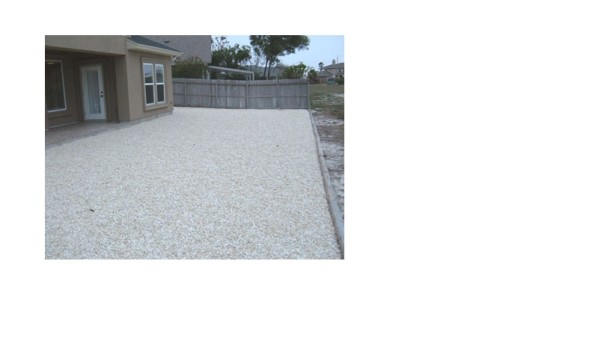 Here in Southern California, as in many other areas, we are finally legally recognizing the drought. There are rebates in place for those who take out their lawns, and here in Fallbrook there is a 36% water reduction goal. Many people just don’t know what to do with all that lawn. A very unfortunate continuing trend is to dump half a ton of colored gravel on it. Please! NO! First of all, once down gravel is nearly impossible to get out again. Gravel, like all rocks, is thermal mass. Instead of having a large rock heating up and radiating out heat, with gravel there are tens of thousands of surfaces radiating out heat and reflecting light and heat back up. It is the worst kind of hardscape. All that reflected heat and light heats up your home, making you use your air conditioner more frequently which is a waste of energy, and also dries out the air around your home. Desertification reflects light and heat to a point where moist air moving over a region dries up. There is less rain, or no rain. Most trees and plants trap humidity under their leaves. Gravel reflects light and heat back up under those leaves and dries them out, sickening your plants and trees. Pollen travels farther on humid air; it can dry out quickly. If you are relying on pollination for good fruit set between trees that are spaced far apart, then having some humidity will increase your chances of success.
Here in Southern California, as in many other areas, we are finally legally recognizing the drought. There are rebates in place for those who take out their lawns, and here in Fallbrook there is a 36% water reduction goal. Many people just don’t know what to do with all that lawn. A very unfortunate continuing trend is to dump half a ton of colored gravel on it. Please! NO! First of all, once down gravel is nearly impossible to get out again. Gravel, like all rocks, is thermal mass. Instead of having a large rock heating up and radiating out heat, with gravel there are tens of thousands of surfaces radiating out heat and reflecting light and heat back up. It is the worst kind of hardscape. All that reflected heat and light heats up your home, making you use your air conditioner more frequently which is a waste of energy, and also dries out the air around your home. Desertification reflects light and heat to a point where moist air moving over a region dries up. There is less rain, or no rain. Most trees and plants trap humidity under their leaves. Gravel reflects light and heat back up under those leaves and dries them out, sickening your plants and trees. Pollen travels farther on humid air; it can dry out quickly. If you are relying on pollination for good fruit set between trees that are spaced far apart, then having some humidity will increase your chances of success.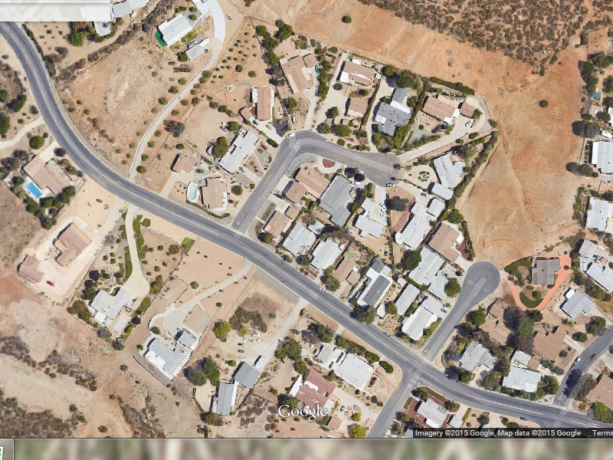
An area of Wildomar, surrounded by hillsides of chaparral that hasn’t been destroyed. These homes have mostly gravel yards and denuded, compacted backyards. Very little rain penetrates, and all the weeds that nature sends it to help repair this gash in the earth are promptly poisoned. This is death to us and our planet. By laying gravel you are turning soil into rock-hard dirt, because microbial life cannot live closely under it. That robs any plants you have stuck into the gravel of the food they need from the soil, which is opened up through microbial activity. You are adding to the heat value of the hardscape around your house causing you to cook in the summer and use more air conditioning. You have reduced habitat to zero. You have added to global warming by reflecting more heat and light into the sky. Although gravel is permeable, usually the ground below it bakes so hard that rain doesn’t percolate. I’ve read sites that want to you increase the albedo effect by laying gravel. In the short term albedo helps cool the atmosphere, but as a result of too much reflected light dries everything out. Think of the dark coolness and dampness of forests… that are now bare ground.
What do you do with your lawn instead? There are many choices that are so much better for the earth and your quality of life. First step, cut swales on contour on any slopes for best rain harvesting. Flat lawn? Easier still. Turn your lawn into a beautifully landscaped lush native garden. I’m not talking about a cactus here and there, but a creation with the awesome native plants we have in Southern California. Some of them such as Fremontia can die with supplemental summer water!

A beautiful border and plantings of California natives. Very low water use here, and very high habitat! There is a chocolate daisy that smells like chocolate. Oh yes. And how can you not want to plant something called Fairy Duster or Blue-Eyed Grass? A native landscape planted on soil that has been contoured to best catch and hold water, and amended with buried wet wood (hugelkultur), will give much-needed food, water and breeding grounds to countless birds, butterflies, native insects and honeybees.
Or put in a pond. Wait, a pond during a drought? Yes! Ninety-nine percent of California wetlands have been paved over, drained or are unusable. Where are all the animals drinking? Oh, wait, we are in the epicenter of extinction, mostly due to wetlands loss. There are very few animals left that need to drink. Those that are left have to take advantage of chlorinated water in bird baths and swimming pools. The microbially rich and diverse clean, natural water that fed and sustained life is just about gone. So what can you do? If you have a swimming pool, you can convert it either entirely to a pond, or into a natural swimming pool that is cleaned by plants.
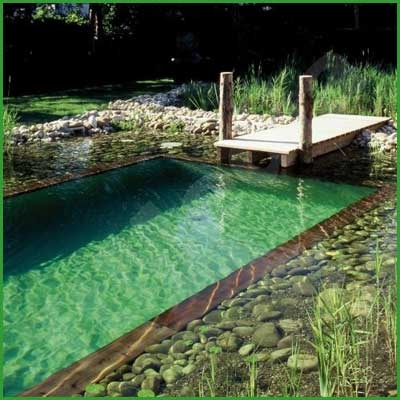
A natural pool upgrades your pool to a lovely pond without the use of chemicals. Suddenly instead of having this expensive eyesore that you use only a couple of months a year and pour chemicals into year-round, you have a lovely habitat that you want to sit and watch, and even better, swim in safely without turning your hair green or peeling your skin. You don’t need to clean the pool all the time, and you don’t need to put in chemicals. If you are in the San Diego or Los Angeles area, call Dr. Robert Lloyd of PuraVida Aquatics for a consultation and conversion. If you don’t have a pool, then build one that is cleaned by plants and fish. You don’t need a filtration or oxygenation system because the biology does it all. Where do you get the water from to top off your pond?
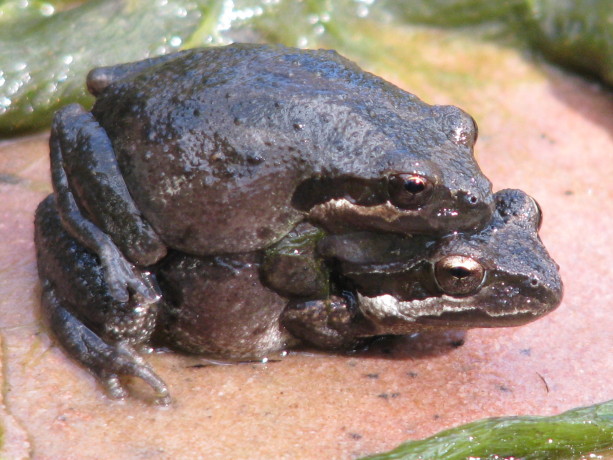
Native Pacific Chorus Frogs enjoying our clean pond at Finch Frolic Garden. Connect your pond to a lovely, planted stream that is connected to your laundry water or graywater system. You are buying water every day, so why not compost your water through phytoremediation and have a pond full of great healthy chemical-free water that is wonderful to look at and is an oasis for thirsty animals and insects?
Or install a food forest. With good soil building and rain catchment first, and planting in guilds with sheet mulch around trees and on pathways, you will be using a fraction of the water you pour on your lawn and yet harvest lots of food. Too much food? Share it with a food pantry!
Or start a veggie garden without digging any sod.

Create a lasagna garden right on top of the lawn and start growing immediately. Layer cardboard, sticks, grass, food scraps, leaves, more grass, more food scraps, more leaves and top it with about 8 inches of good soil, then plant right in it! That lovely standing compost heap will slowly turn into good soil while killing the grass beneath and growing crops for you immediately.
If ridding yourself of a lawn just breaks your heart, then substitute the high-water use grasses for a native grass mix that is comparable. Look at S&S Seeds for prices or for seed choices. Water a few times with Actively Aerated Compost Tea using any rainwater you may have caught in those 50-gallon containers and your grass roots will travel so deeply that they will find groundwater. Check up on the work of soil microbiologist Dr. Elaine Ingham and see how easy AACT is to make and use.
There are so many alternatives to using gravel that aren’t expensive, that are an investment in your property and in reclaiming habitat while beautifying your home and saving money. So please, just say, “NO,” to the gravel. Tell a friend!!
Which one of these would you rather live in? Which do you think is better for the earth and for the future generations?

Finch Frolic Garden, year 3.


